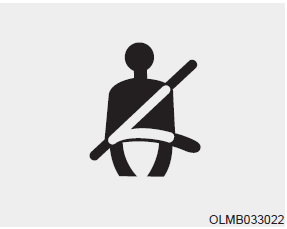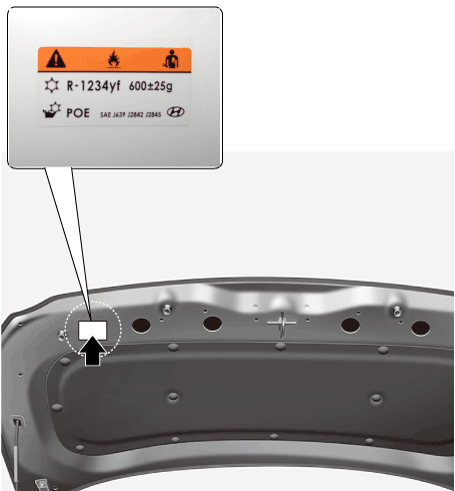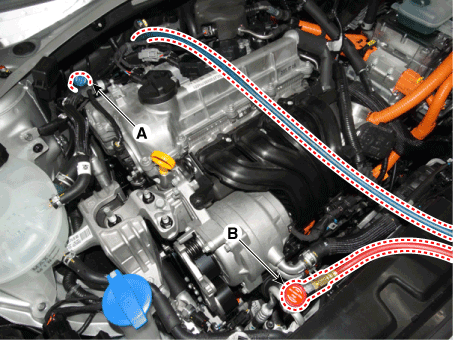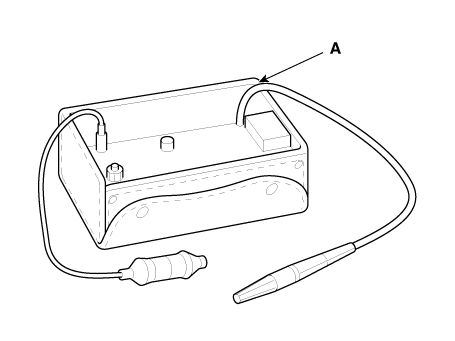Hyundai Ioniq: Air Conditioning System / Repair procedures
| Refrigerant System Service Basics |
Refrigerant Identification
| • | Do not mix HFO-1234yf (R-1234yf) in the vehicle with other refrigerant, such as R-12, R-134a and etc. |
| • | Use only service equipment that is U.L-listed and is certified to meet the requirements of SAE standards to recover and recycle R-1234yf from the air conditioning system. Do not use service equipment for the other refrigerant, such as R-12, R-134a and etc. |
| • | Verify what refrigerant is in the system if there is concern that the system has been tampered with in any way and check the type and quantity of refrigerant that shall be in the A/C system and potential issues arising from accidental or intentional mixing of refrigerants. |
| • | Using an SAE certified refrigerant identification device is recommended to prevent improper recovery and the resulting further spread of contaminated refrigerant, which could potentially damage other A/C systems and service equipment. Contaminated refrigerant (blend of more than one refrigerant or non-system refrigerant) in recovery / recycling equipment could lead to the potential contamination of more refrigerant. |
| • | Certain types of electronic leak detection devices (heated diode or corona discharge) as well as motors, switches, and controls on recovery and recycling machines, could generate sparks that could serve as ignition sources in the presence of refrigerants classified as flammable (A2 or A3) by ASHRAE standard 34 2006. |
| • | It is possible that the mixing of refrigerants in a A/C system can result in higher-than-expected system pressures, system and component damage, diagnostic errors and/or other potential hazards to people and environment. |
| • | In case other refrigerant is mixed, recover the contaminated refrigerant in the A/C system and dispose it in accordance with all applicable national, regional or local regulations. Clean inside the A/C system using the specialized detergent and recharge new refrigerant. |
Refrigerant specification
| 1. | Check the refrigerant specifications inside the hood before recovering/charging the refrigerant.
|
Refrigerant Recovery
Use only service equipment that is U.L-listed and is certified to meet the requirements of SAE standards to remove HFO-1234yf (R-1234yf) from the air conditioning system.
|
|
If accidental system discharge occurs, ventilate work area before resume of service.
Additional health and safety information may be obtained from the refrigerant and lubricant manufacturers.
| 1. | Connect an R-1234yf refrigerant Recovery / Recycling / Charging System to the high-pressure service port (B) and the low-pressure service port (A) as shown, following the equipment manufacturer's instructions.
|
| 2. | Measure the amount of refrigerant oil removed from the A/C system after the recovery process is completed. Be sure to install the same amount of new refrigerant oil back into the A/C system before charging. |
System Evacuation
Use only service equipment that is U.L-listed and is certified to meet the requirements of SAE standards to remove HFO-1234yf (R-1234yf) from the air conditioning system.
|
If accidental system discharge occurs, ventilate work area before resume of service.
Additional health and safety information may be obtained from the refrigerant and lubricant manufacturers.
| 1. | When an A/C System has been opened to the atmosphere, such as during installation or repair, it must be evacuated using an R-1234yf refrigerant Recovery / Recycling / Charging System. (If the system has been open for several days, the receiver / dryer should be replaced, and the system should be evacuated for several hours.) |
| 2. | Connect an R-1234yf refrigerant Recovery / Recycling / Charging System to the high-pressure service port and the low-pressure service port as shown, following the equipment manufacturer's instructions. |
| 3. | If the low-pressure does not reach more than 87.7 kPa (658 mmHg, 25.9 in.Hg) in 5 minutes, there is probably a leak in the system. Partially charge the system, and check for leaks (see "Refrigerant Leak Test"). |
| 4. | Remove the low pressure valve from the low-pressure service port. |
System Charging
Use only service equipment that is U.L-listed and is certified to meet the requirements of SAE standards to remove HFO-1234yf (R-1234yf) from the air conditioning system.
|
If accidental system discharge occurs, ventilate work area before resume of service.
Additional health and safety information may be obtained from the refrigerant and lubricant manufacturers.
| 1. | Connect an R-1234yf refrigerant Recovery / Recycling / Charging System to the high-pressure service port as shown, following the equipment manufacturer's instructions. |
| 2. | Charge the refrigerant as much as the specified amount using the R-134a retrieval/reproduction/charging device while the high pressure valve is open. Close the high pressure valve afterward.
|
| 3. | Check if the refrigerant does not leak from the system with a leakage detector (refer to Refrigerant Leakage Inspection). |
Refrigerant Leak Test
Always conduct a leak test with an electronic leak detector whenever leakage or refrigerant is suspected and when conducting service operations which are accompanied by disassembly or loosening or connection fittings.
|
|
If a gas leak is detected, proceed as follows :
| 1. | Check the torque on the connection fittings and, if too loose, tighten to the proper torque. Check for gas leakage with a leak detector (A). |
| 2. | If leakage continues even after the fitting has been tightened, discharge the refrigerant from the system, disconnect the fittings, and check their seating faces for damage. Always replace, even if the damage is slight. |
| 3. | Check the compressor oil and add oil if required. |
| 4. | Charge the system and recheck for gas leaks. If no leaks are found, evacuate and charge the system again.
|
 Components and components location
Components and components location
Component Location IndexEngine Room1. Expansion valve2. Service port (Low pressure)3. Service port (High pressure)4. Discharge hose 5. Suction & Liquid tube assembly6...
Other information:
Hyundai Ioniq (AE) 2017-2025 Owner's Manual: Engine Start/Stop Button
Whenever the front door is opened, the Engine Start/Stop button will illuminate and will go off 30 seconds after the door is closed. WARNING To reduce risk of serious injury or death, NEVER allow children or any person who is unfamiliar with the vehicle to touch the Engine Start/Stop button or related parts...
Hyundai Ioniq (AE) 2017-2025 Service Manual: Rear Disc Brake. Components and components location
Components[EPB None Apply]1. Brake pad2. Pad return spring3. Caliper carrier4. Pad retainer5. Caliper body6. Bleed screw7. Stopper8. Return spring9. Operating lever[EPB Apply]1. EPB Actuator2. Bleed screw3. Caliper body4. Caliper carrier5. Pad retainer6...
Categories
- Manuals Home
- 1st Generation Ioniq Owners Manual
- 1st Generation Ioniq Service Manual
- Auto Door Lock/Unlock Features
- Temperature control
- Jump Starting
- New on site
- Most important about car
Seat Belt Warning Light
Seat belt warning light

As a reminder to the driver, the seat belt warning light will illuminate and warning chime will sound for approximately 6 seconds each time you place the Engine Start/Stop button to the ON position if the seat belt is unfastened.
Copyright © 2025 www.hioniqae.com







